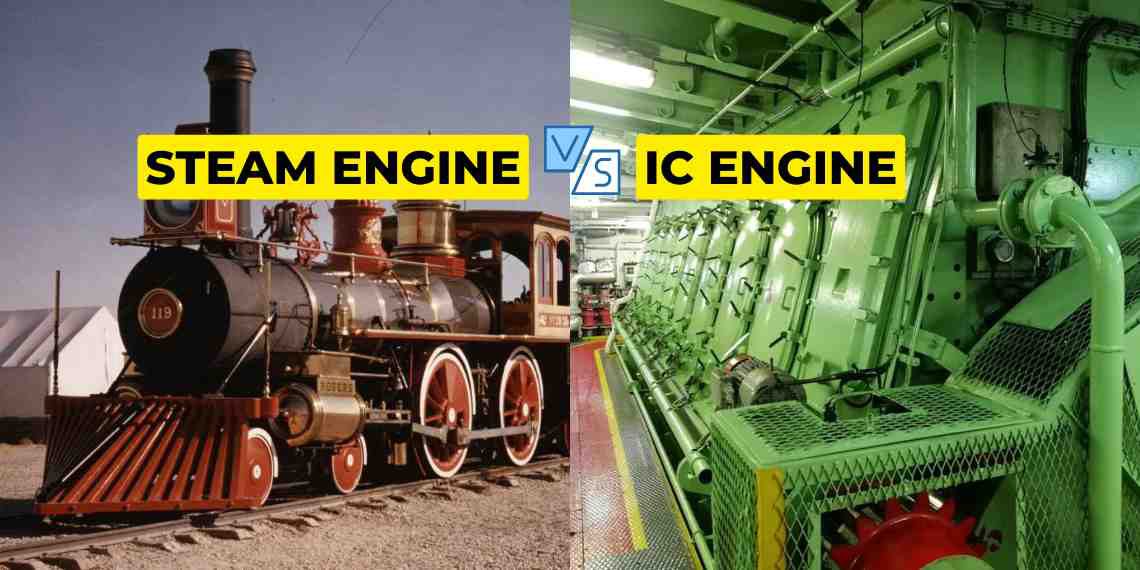Steam Engine Vs IC Engine
The steam engine and the internal combustion engine (IC engine) are two distinct types of engines that have played vital roles in different periods of history. In the 18th century, engineers invented the steam engine, which was one of the first practical engines to harness the power of steam. It was one of the key inventions of the industrial revolution and played a vital role in powering various industries, transportation systems, and machinery.
On the other hand, the internal combustion engine, particularly the gasoline engine, gained prevalence in the late 19th century. It has since remained the primary power source for automobiles, even to this day.
What is a steam engine?
Steam engine: A steam engine is a heat engine that uses steam as its working fluid to convert the heat energy of steam into mechanical energy.
Steam engines typically operate by heating water in a boiler, creating steam under high pressure. The pressurized steam directs into a cylinder where it expands, pushing a piston back and forth. The piston converts its reciprocating motion into rotational motion using a crankshaft, which powers machinery or propels locomotives and ships.
In the 18th and 19th centuries, steam engines found widespread use and had a significant impact on transportation, manufacturing, and power generation. They powered steam locomotives, steamboats, and early industrial machinery, driving the growth of railways and factories. However, with advancements in technology, the steam engine was eventually largely replaced by more efficient internal combustion engines and electric motors. Nonetheless, steam engines still find niche applications today. For instance, they are used to power steam-driven turbines in power plants and to propel steam-powered heritage trains.

What is an Internal combustion engine?
Internal combustion engine: IC engine stands for Internal Combustion Engine, which is a type of heat engine that uses the combustion of fuel to generate power. In an IC engine, the engine’s cylinders burn fuel, converting the generated heat into mechanical energy. The IC engine utilizes this mechanical energy to rotate a crankshaft, which in turn drives the wheels of a vehicle or powers a machine.
IC engines can be further classified into two main types based on their ignition system:
- Spark-Ignition Engines (SI engines): These engines use a spark plug to ignite the fuel-air mixture. They are commonly found in gasoline-powered vehicles.
- Compression-Ignition Engines (CI engines): These engines rely on the heat generated by compressing the air in the combustion chamber to ignite the fuel. They are commonly found in diesel-powered vehicles.

Difference between Steam engine and Internal Combustion engine
| Steam engine | IC engine |
| Steam is produced in the boiler which goes to the engine and drives it | Fuel is burnt inside the combustion chamber of the engine |
| Less working pressure inside the engine | 2. Very high working pressure & temp inside the engine (components needs to be much more sturdy) |
| Efficiency, η=12% to 18% | 3. Efficiency, η=36% to 42% |
| Long & tedious process | 4. Can be started instantaneously |
| High weight to power ratio | 5. Less weight to power ratio |
| Large size | 6. Compact size |
Q: Why do we prefer an IC engine over a steam engine?
IC engines are generally preferred over steam engines in many modern applications for the following reasons:
- Higher power-to-weight ratio: IC engines have a higher power-to-weight ratio compared to steam engines. This means that they can generate more power relative to their weight and size, making them more efficient and easier to install in smaller spaces.
- More responsive: IC engines can start and stop quickly and respond rapidly to changes in power demand. On the other hand, steam engines exhibit a slower response time compared to other engines. Additionally, they require more time to heat up and build steam pressure.
- Lower fuel consumption: IC engines are generally more fuel-efficient than steam engines. This is because a lot of fuel is consumed to boil water and produce steam.
- Lower maintenance requirements: IC engines require less maintenance compared to steam engines. They have fewer moving parts and do not require water treatment and boiler maintenance, which can be expensive and time-consuming.
Note
If you want to learn more about this topic, we suggest checking out our Combo package with the given link https://merchantnavydecoded.com/courses/c/ . It’s a great way to dive deeper into the subject through video explanations. This package covers all the important details and presents them in an easy-to-understand format. Watching the videos will help you grasp the topic better and make learning more enjoyable. So, we highly recommend giving our Combo package a try to enhance your knowledge on the subject.
Disclaimer :- The opinions expressed in this article belong solely to the author and may not necessarily reflect those of Merchant Navy Decoded. We cannot guarantee the accuracy of the information provided and disclaim any responsibility for it. Data and visuals used are sourced from publicly available information and may not be authenticated by any regulatory body. Reviews and comments appearing on our blogs represent the opinions of individuals and do not necessarily reflect the views of Merchant Navy Decoded. We are not responsible for any loss or damage resulting from reliance on these reviews or comments.
Reproduction, copying, sharing, or use of the article or images in any form is strictly prohibited without prior permission from both the author and Merchant Navy Decoded.



Its is such a good material for every student
Hello Mohy,
Thankyou for your appreciation, we will try provide like this content continue.
Team Merchant Navy Decoded.